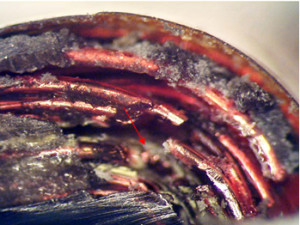Failure Analysis on Pulse Transformers
Gideon Analytical Laboratories received six pulse transformer. Three were good, three were failures. Transformers can be thought of as an electrical component rather than an electronic component. A transformer basically is very simple static (or stationary) electro-magnetic passive electrical device that works to convert electrical energy from one value to another. The transformer does this by linking together two or more electrical circuits using a common oscillating magnetic circuit which is produced by the transformer itself. A transformer operates on the principle of electromagnetic induction. Faraday’s Law, which states that a time-varying magnetic field can induce a time-varying voltage in a loop of wire, is how transformers work. Usually, this accomplished by wrapping multiple turns of wire around some type of ferromagnetic material. Usually, there are two sets of windings: a primary and a secondary. The primary winding is attached to the generator; the secondary side is attached to the load. For this job, the goal was to determine the cause of the failures and inspect the other unused transformers for possible workmanship, material, or process that may have contributed to the cause of the failures experienced. Gideon Analytical Laboratories conducted electronic failure analysis on the transformers. Several different types of tests were run, as indicated by the table below:
| Sample | Hermetic | Cavities | Neck down | Chlorides | Dye penetration | Wire coating | electrical | Potting |
|---|---|---|---|---|---|---|---|---|
| 1 | No | yes | Yes | Yes | yes | ND | fail | ND |
| 2 | No | Yes | Yes | Yes | ND | poly(amideimidoether) on poly(esteramidoimide) | fail | silica, epoxy resin, and a hydrocarbon containing an ester group |
| 3 | No | Yes | Yes | Yes | Yes | ? | ||
| 4 | Yes | Yes | No | No | ND | poly(amideimidoether)on poly(esterimide) | pass | silicate filler in epoxy resin |
| 5 | ND | ND | ND | ND | ND | ND | pass | ND |
| 6 | No | Yes | No | yes | ND | Same as #2 | pass | Same as #2 |
Failures resulted from neckdowns and scintillation. There was also chloride present in the virgin package. Ubiquitous cavities in the presence of non-hermetic seals suggest a poor encapsulation process. The potting material had polyesters that could hydrolyze and contribute to failures. In sum, these transformers were in really bad shape. Gideon Analytical Laboratories can be brutally honest. But what else would you want in an analytical laboratory? We give electronics companies candid, accurate, and fact-based assessments of their products. We can determine why almost anything electrical is failing. Is it design? manufacturing? application? Is it your process? Is it assembly? We can determine what parts are failing and why. We are here to help you. We are here to ease your burden. Let us help save you time and money. If you want the mystery solved, give Gideon Analytical Laboratories a call today. 845-255-5356

Arrow points to place where moisture ingress can occur

Micrograph of Sample 1 at neck down

BTA16-800

Lack of sealing

Bottom of transformer, dye penetration under black light

Failure site, sample 2

Sample 1, dye shows it is vulnerable to penetration